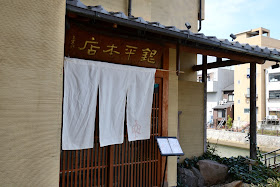We didn’t really plan our holidays around the spring sakura season so we considered ourselves lucky to have caught an early glimpse of the blossoming cherry flowers while touring around Wakayama Prefecture in late March right before the Easter long weekend. Wakayama on the south-west side of Kii Peninsula may not be as popular a destination for sakura viewing, or hanami in Japanese, as Kyoto or even Osaka nearby, there were quite a few spots where cherry trees were planted, which gradually turned into a sea of pinks and whites beginning at around late March and peaked in early April.
Guess only in Japan the weather report often included the “Sakura Forecast” which gave fairly accurate prediction of when and where to view the cherry blossom at any given time, so we knew ahead of time where we should be going and what we should be expected seeing.
Our first stop was Kimiidera Temple (紀三井寺), originally built over 1200 years ago on the hillside, with the giant standing golden Kannon Buddha (千手觀音) statue inside one of the pagodas on the ground. In the park next to it over 500 cherry trees were planted, and they were around 30% bloomed on the day of our visit, just as the Sakura Forecast predicted. The Wakayama Castle, another popular hanami site in the city, was similar, with stall vendors beginning to set up on the footpaths leading to the castle for the weekend, when scores of visitors were expected for the weeklong cherry blossom festival day and night.
We stopped by a restaurant called Ginpei near to Wakayama Castle for lunch. It’s one of the more famous restaurants in town, with branches in Tokyo, Osaka and even Shanghai, China. This small restaurant, with only counter seating and a couple private rooms, is known for its regional cuisine and seafood dishes, especially tai, or sea bream. We went for their signature “Tai-meshi” set lunch menu, which began with an appetizer platter followed by a few types of sashimi – both shimaji (striped jack) and buri (wild yellowtail) were excellent. A small tray of soba noodles then arrived in a rattan basket, made in-house and served with a warm soy-dashi broth and chunks of simmered sea bream in a lacquer bowl.
After the tempura course (with prawns, pumpkin and fukinoto), we were then served with a couple sea bream courses, with the fish coming from Kada Bay nearby. First was Tai Nitsuke, with each of us getting half of the sea bream simmered in a soy-based broth accented by plum, another famous produce of the prefecture. The meat was well-infused with the soy sauce flavor from the slow cooking yet retained its delicate texture – it’s simple yet delicious. We finished with Tai-meshi (鯛めし), the signature dish of the restaurant, with rice cooked in a large earthenware pot with the sea bream and fish stock, then the fish was deboned and the meat mixed with the rice to serve in small bowls. It’s a traditional, home-style dish just perfectly prepared – the rice was moist and plump and of the right stickiness, and the grain was infused with the subtle umami flavor from the cooking stock, and mixed with bits of the tasty fish meat in every mouthful.
When? March 23 2018
Where? Ginpei Honten, Juichibancho 22, Wakayama-shi, Wakayama Prefecture, Japan
Menu Highlights: Tai-meshi (Sea Bream Rice)
Web: www.ginpei.com/html/shop/honten.html
(Part of the Wakayama Travel Series)











No comments :
Post a Comment